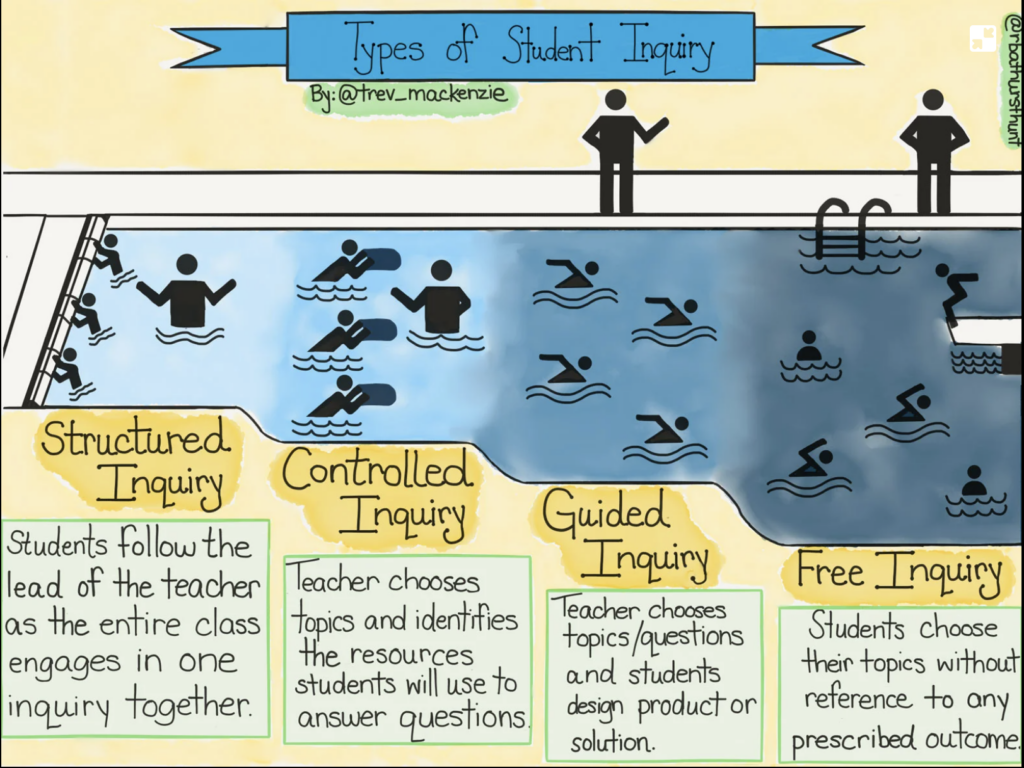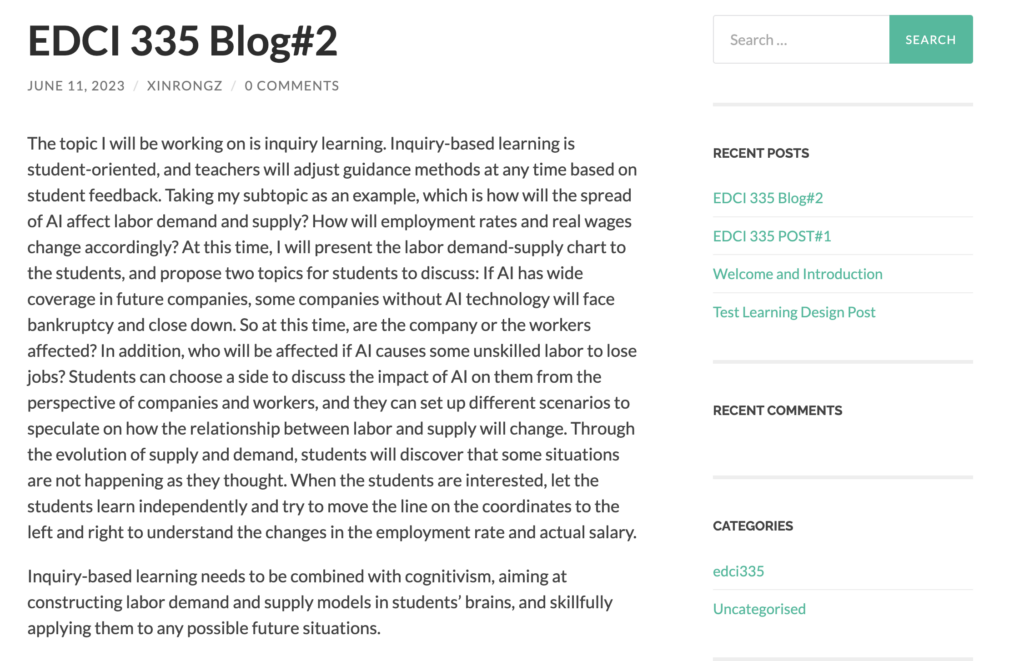What is Inquiry-Based Learning?
Unlike direct instruction whereby pedagogical practices are designed, scaffolded, and presented by educators, inquiry-based learning “places the responsibility for learning on the students and encourages them to arrive at an understanding of concepts by themselves” (Queens University, n.d., para 1). Essentially, inquiry-based learning is an “array of classroom practices that promote student learning through guided and, increasingly, independent investigation of complex questions and problems, often for which there is no single answer” (Lee at el., 2004, p.9, as cited in Queens University, n.d., para 1).
Levels of Inquiry
An inquiry approach to learning includes four types of student inquiry, that being structured inquiry, controlled inquiry, guided inquiry, and free inquiry. This scaffolded methodology is “one that gradually increases student agency over learning while providing learners with the necessary skills, knowledge, and understanding to be successful in their inquiry” (MacKenzie, 2016, para 3).

Characteristics of Inquiry-Based Learning
Llego (2022) outlines the following key characteristics of an inquiry-based approach to learning (para 4-8):
- Inquiry-styled learning is active, not passive: Instead of “receiving information from a teacher or textbook”, “students are actively engaged in posing questions, finding information, and making sense of what they find” (Llego, 2022, para 4).
- Inquiry-based learning starts with a question, problem, or scenario: Inquiry-styled learning starts with an open-ended question that “gives students a purpose for their learning and allows them to focus on finding a solution” (Llego, 2022, para 5).
- A teacher or other adult facilitates it: The responsibility of the facilitator is to help students ask good questions, find relevant information, and make sense of what they find” (Llego, 2022, para 6).
- Inquiry-based learning can be utilized in formal and informal educational settings: Inquiry-based learning can be applied in the classroom at any time, but it is “particularly well suited for” activities that incorporate “problem-solving, critical, and creative thinking” (Llego, 2022, para 8).
- Finding an answer to your inquiry question may not happen: Because inquiry questions are supposed to be open-ended, students may not find an explicit answer to their question(s).
Inquiry-Based Learning: Art Therapy
An Inquiry-based learning approach pertaining to art therapy would be immensely rewarding for learners. The objective of art therapy aligns with the benefits and key characteristics of inquiry-based learning by encouraging creativity, improving problem-solving skills, encouraging engaged, meaningful learning, connecting learning to real-world experiences, and helping students understand complex topics like the healthy expression and communication of emotions (Scholl, 2023, para 12-18). For instance, one of the many advantages of inquiry-based learning is its ability to improve communication skills. By using various artistic modalities such as painting, sculpting, drawing, photography, etc., learners can express, work through, and communicate emotions and/or how they are feeling. Possessing the ability to identify, communicate, and resolve a feeling is not always an easy task. The scaffolded nature of inquiry would allow students to progressively gain the tools needed to build emotional intelligence by initially following the lead of the teacher (structured inquiry), whilst working up to students autonomously deciding how to utilize artistic expression (free inquiry).

Subsequently, while I would place inquiry-based learning under the learning theory of constructivism as it “equates learning with creating meaning from experience” via the integration of real-world experiences, it is interesting to note that peers of mine believe inquiry-based learning needs to be combined with cognitivism. Rosina, after reading your blog post, I was inspired to research the features of both cognitivism and constructivism to see where inquiry-based learning resides. Whilst these learning theories overlap quite a bit, “the key difference between constructivism and cognitivism is that constructivism explains that learners use prior knowledge to understand new knowledge, while cognitivism explains that learning takes place through the internal processing of information” (Kumari, 2022, para 1). In my own experiences with inquiry, I have used prior knowledge to help formulate my inquiry question. For example, when completing my inquiry project on brain breaks in terms of sustaining engagement, I utilized my prior knowledge/experience with brain breaks to help drive my inquiry project and construct my questions. Conversely, successful inquiry projects incorporate a certain level of self-reflection; an individual must intrinsically process information in order to go forward in the inquiry process. Furthermore, whilst inquiry-based learning incorporates elements of both learning theories, I believe the root of inquiry-styled learning stems from constructivism.
References
Edutopia. (2016). Inquiry-based learning: developing student-driven questions [Video]. YouTube. https://www.youtube.com/watch?v=OdYev6MXTOA&ab_channel=Edutopia
Edutopia. (2016). Inquiry-based learning: from teacher-guided to student-driven [Video]. YouTube. https://www.youtube.com/watch?v=mAYh4nWUkU0&ab_channel=Edutopia
Ertmer, P. A. & Newby, T. (2018). Behaviourism, cognitivism, constructivism: comparing critical features from an instructional design perspective. In R.E. West (Ed.), Foundations of Learning and Instructional Design Technology. EdTech Books. https://edtechbooks.org/lidtfoundations/behaviorism_cognitivism_constructivism
Kumari, G. (2022). What is the difference between constructivism and cognitivism. Compare the Difference Between Similar Terms. https://www.differencebetween.com/what-is-the-difference-between-constructivism-and-cognitivism/#:~:text=The%20key%20difference%20between%20constructivism,the%20internal%20processing%20of%20information.
Llego, M.A. (2022). Inquiry-based learning: what is it and why you should use it. TeacherPH. https://www.teacherph.com/inquiry-based-learning/
MacKenzie, T. (2016). Bringing inquiry-based learning into your class. Edutopia. https://www.edutopia.org/article/bringing-inquiry-based-learning-into-your-class-trevor-mackenzie/
Queens University. (n.d.). Inquiry-based learning. https://www.queensu.ca/ctl/resources/instructional-strategies/inquiry-based-learning
Scholl, A. (2023). What Is Inquiry-Based Learning? Types, Benefits, Examples. SplashLearn Blog – Educational Resources for Parents, Teachers & Kids. https://www.splashlearn.com/blog/what-is-inquiry-based-learning-a-complete-overview/
Spencer, J. (2018). What is inquiry-based learning? [Video]. YouTube. https://www.youtube.com/watch?v=QlwkerwaV2E&ab_channel=JohnSpencer
Hi Katie! It was really insightful to hear your thoughts on Inquiry-Based Learning and its unique characteristics. Thinking about how inquiry-based learning could be applied to art therapy is interesting. I can imagine that asking open-ended questions and encouraging exploration could lead to some really meaningful and insightful artistic creations and self-discoveries.
Also, thank you for sharing your experiences with inquiry-based learning. It’s great to hear about your personal insights and perspectives on this approach. I hope you found it to be a valuable and rewarding experience.
Finally, I wanted to mention that I appreciate the use of supplemental resources, which helped support your points.